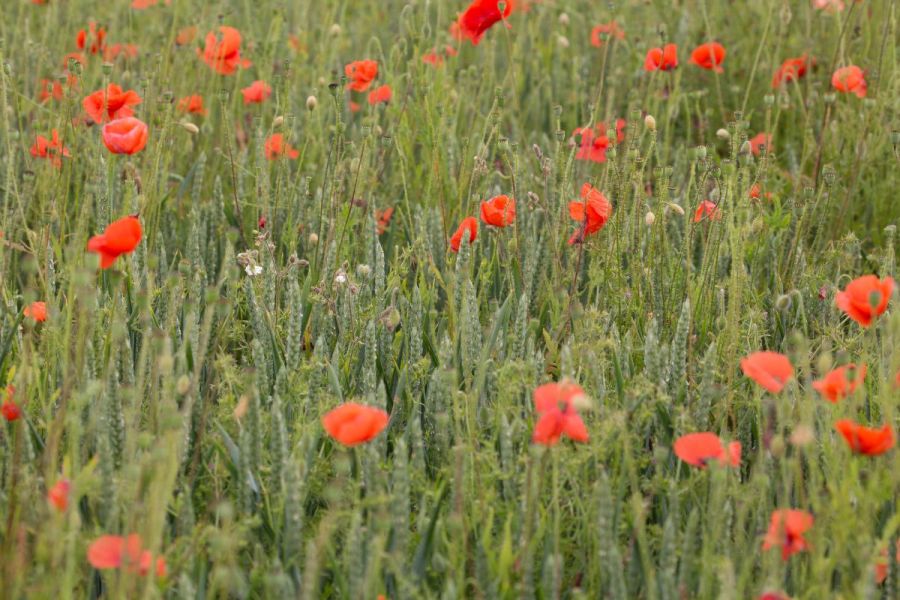As a long-standing member of the chemical armoury, there’s still great value in using phenoxy herbicides. CPM gets advice from the experts on what exactly they are and how growers could be using phenoxies this season.
“One of the biggest myths surrounding phenoxies is that they don’t get into the root system – that is completely untrue.”
By Charlotte Cunningham

One of the biggest advantages of phenoxies is that they don’t have the same resistance issues that are being seen with the ALS-type products, says Laurence Power.
They may have been available for several decades, but phenoxy herbicides still have an important role to play in spring broadleaf weed control – plugging the gaps in herbicide programmes and providing an alternative mode of action to the ALS group of chemistry.
CPM speaks to Laurence Power lead agronomy manager at Nufarm to get his advice on when and where phenoxy herbicides could be used, while ADAS’ Sarah Cook discusses the current resistance status of broadleaf weeds.
How are crops looking this spring?
As always, it’s a very mixed, regional picture. Some crops in the Suffolk and Norfolk areas seem to have come through the winter very well – herbicide programmes have been strong and done a really good job.

Groundsel is becoming particularly problematic in some regions in the UK.
Working up into Lincolnshire and the East Midlands, it’s a bit more of a story of two halves. A lot of wheat was drilled early, and though herbicide programmes were put on, weeds have still come through. Groundsel is one that is being talked about quite a lot and a new weed, that seems to be problematic where you get it, is bur chervil. Such is the case for poppies and chickweed – they’re both very problematic where present, too.
On our own farm in Derbyshire, I’m really pleased with the weed control in our wheat, but a little bit disappointed with the barley. That’s purely because the barley went in first, followed by the wheat, and mayweed and groundsel have come through – despite the programme – which is really disappointing.
With this in mind, a spring clean-up might be very valuable in some areas and go as early as possible if this is something you need to do. Ideally before the T0 timing, but at least at T0 if this isn’t possible so that herbicides are on in advance of theto leave the T1 timing
Where do phenoxies best fit?

Phenoxies can be used in both winter and spring cereals on a range of weeds including chickweed, fat hen and groundsel.
Using phenoxies can be quite flexible, but they do fit particularly well in those earlier timings – anything up to GS32. A lot of phenoxies shouldn’t be used past this point anyway.
Tackle weeds as early as possible – the more time they stay the ground, the more that is being taken away from the crop. So with an early window in mind, phenoxies can be a really useful part of the crop protection strategy.
This is one of its strengths, but one of the biggest advantages of phenoxies is that we don’t have the resistance issues that exist with the ALS-type products. The statistics show that currently there are 97 different species of weeds that are showing some sort of sensitivity to ALS-inhibitor herbicides.
Resistance can show itself in different ways on different farms, but essentially, what this means is that we’re not getting the good control that we used to see with the ALS herbicides alone. This is where phenoxies can come in, as they don’t have these same resistance issues, and therefore as an active do a really good job.
They can be used alongside ALS products, or in a tank-mix, but essentially, phenoxies offer a really good opportunity to avoid further resistance issues building up.
Of course, all products have their weaknesses, and with phenoxies it’s probably the growth stage timing – they need to be on before GS32. Though this maybe a good thing as it forces growers to get on with weed control early.
How do they work?
Phenoxies are a group of herbicides, first developed in the 1940s, which work by mimicking the effect of auxins – natural plant hormones. The role of auxins is to regulate growth and, specifically, to help plants grow towards light.
The phenoxy group includes MCPA, 2,4-D, CMPP-P and MCPB and has been designed to manipulate this function and are able to mimic it to the advantage of weed control – causing target weeds to thicken, twist and grow rapidly in a way that is detrimental to the weed, which ultimately causes them to wilt and die.
As a weed control option, phenoxies are quite flexible and can be used alone to control specific weeds, such as thistles, combined with other phenoxies or with other broadleaf weed herbicides – like florasulam or sulfonylureas – as part of a tank-mix to provide more wide-spectrum control. The type of weed control possible is product-dependent but includes some of the most problematic weeds such as chickweed, fat hen and groundsel. They can be used in both winter and spring cereals.
One of the biggest myths surrounding phenoxies is that they don’t get into the root system – that is completely untrue.
We’ve done a lot of different trial work which shows that phenoxies do indeed move into the root systems and do kill into the root. On our own farm, trials have compared thistles treated with phenoxies with thistles which haven’t. This involved digging up the root system and the discolouration in the roots where the phenoxies had got into the system and killed the weed could clearly be seen.
What’s the best timing?
For best effect, growers should be targeting the earlier windows – ideally GS28-30 – though the upper limit to this is variable depending on the product. In terms of weed size, the smaller the better for control.
The right environmental conditions are important too. Phenoxies take about four to six rain-free hours to get into the plant, so avoid spraying if the forecast is looking inclement. It’s also important to avoid frost conditions.
Due to phenoxies solubility, it’s important to be mindful of where you’re spraying – particularly near watercourses. This means not spraying if wind speed is more than 15km/hour and using 3* rated drift reduction nozzles. If in doubt, the best thing to do is not to spray.
How do you optimise application?

Hard water can prevent all chemistry from working effectively – not just phenoxies – so it’s worth considering a water conditioner.
To get the best from phenoxies, weeds must be actively growing and, though it sounds obvious, it’s also important to check the species is actually susceptible. As already discussed, the correct timing is also vital.
Something else that is important to consider is any evidence of crop stress. If the crop is under stress as a result of drought, disease or nutrition, it could limit weed control and actually cause damage to the crop itself.
With regards to water, when using phenoxies it’s important to try to keep to 200 l/ha and in terms of quality, it’s important to get the water checked. If it has too much calcium or magnesium in it, it can affect the efficacy of most herbicides – not just phenoxies. Where hard water is present, using a water conditioner can help get the best out of the chemistry.
Nozzle technology is also important and what you should be aiming for is a medium-fine spray pattern.
What about tank-mixing?
In general, phenoxies have good compatibility with a range of products, though it’s important to remember that we shouldn’t be using more than four products in a tank anyway as good practice.
If using a wetter, which ALS herbicides benefit from too, then there shouldn’t be any issues with regards to compatibility from that respect either.
How about resistance management?
We know that there’s resistance in broadleaf weeds, so having a sound understanding of groups of herbicides is essential when it comes to future resistance management. Phenoxies are in HRAC Group 4 and, at present, have the lowest risk of developing resistance.
But to maintain this, it’s vital to continue to use phenoxies at the appropriate rate and in conjunction with other products – no one active can be used continuously as resistance will inevitably build.
Top tips: Rediscovering phenoxy herbicides
- Target the earlier windows – ideally when the crop is GS28-30 and the smaller the weeds, the better for control
- Consider growing conditions – weeds should be actively growing and the crop stress free, with no rain or frost forecast
- Application matters – consider water volume and quality, adding a water conditioner if necessary. Aim for a medium-fine spray quality
Resistance outlook

Sarah Cook warns that we may just be scratching the surface with regards to the number of resistant broadleaf weed populations.
Though varying levels of resistance to ALS herbicides are known, ADAS’ Sarah Cook warns that we may just be scratching the surface with regards to quite how many populations of broadleaf weeds are affected. “So far, we know of resistance in chickweed, mayweed, poppy and sow thistle. However, the challenge for us is that it’s very difficult to identify cases of resistance and collect the seed, meaning there are more cases out there that we haven’t identified yet.”
Sarah says this is due to both the diversity of UK rotations and deciphering at farm-level whether or not chemistry simply hasn’t worked that year or whether it’s actually more indicative of a resistance issue. “The UK rotation is varied – it includes different crops and different chemistry every year. This makes it quite difficult to pick out if herbicide applications haven’t been successful or whether there is genuine resistance happening.
“I think going forward it’s really important that if growers spot this, then not to just assume they have made a mistake with their programme and to consider the alternative.”
As ALS herbicides are used by so many growers and at all key timings, it’s likely that further resistance will build if it’s not managed carefully – with more resistant populations identified by ADAS over the past year alone, she warns. That said, Sarah says that these types of herbicides are still incredibly valuable. “ALS chemistry is a low-dose option and very effective where they work. They’ve also got a wide range of usage windows – really, they revolutionised weed control.”
So how can growers protect this chemistry going forward? “It’s all about variety – not just within chemistry programmes but also in rotations, so not growing just autumn-sown cereals every year, for example.
“It’s important not to use the same chemistry every year too as this is how a lot of resistance builds up. ALS herbicides have a really big safety zone, so they’re unlikely not to work for no reason – if this is something you start to see, it’s more likely to point towards resistance issues.”
Sarah says this is where alternatives like phenoxies come into play. “Though they can be a bit more restrictive in terms of their timings, phenoxies are an incredibly valuable resource for both weed control and resistance management.”
Looking ahead to the spring, with warmer temperatures than normal it’s important to keep a close and careful eye on growth stages to maximise weed control over the coming months. “As it warms up, and now we’ve had a little rain, things have started to grow and appear quickly. So particularly if you’re using phenoxies, which work best in that early window, pay close attention to growth stage to ensure you can get the control on as quickly and effectively as possible.”
Sponsor message
Combining phenoxies with Nufarm’s range of other herbicides can provide answers to the various agronomic challenges you may find while walking a crop. Our range of agronomy solutions aim to combine mixtures of products catered to the different problem weeds you may find in cereal crops this spring.
We’re proud to be a part of British agriculture, with many of our phenoxies produced directly at our manufacturing plant in West Yorkshire. Whilst Nufarm is a global player in agricultural chemicals, we’re both big and small; our business is large, stable and built on solid values. But we’re small enough to be quick, agile and fuelled by innovative ideas.
This article was taken from the latest issue of CPM. For more articles like this, subscribe here.
Sign up for Crop Production Magazine’s FREE e-newsletter here.




